


To the Border

Monday September 4 – The long road to Kathmandu
Much earlier in the trip, Dorien had announced that instead of going to Kodari, a place just across the border in Nepal, we probably would drive all the way to Kathmandu, giving us two full days in the Nepalese capital.
What she somehow didn’t convey was how long a travel day this made: We left at six in the morning an arrived half past seven in the evening, Nepalese time (two hours and a quarter earlier than Chinese time): Almost sixteen hours of travel.
When we left Tinggri at six in the morning with only some tea in our bellies, it was cold and dark – even with all our layers of clothing. We were shivering in the bus while departing under the winter constellations.
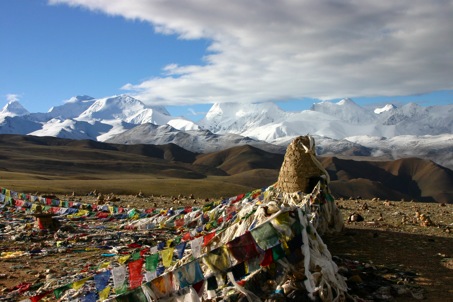 After a good hour of driving in the dark the stars faded and daylight trickled in. After more hours of driving, we finally reached the last pass out of Tibet, the Tong-la (5120 m), not the highest pass of the journey, but definitely the greatest views on a massive row of Himalaya giants (among which the Sishupangma at 8012 m). The idea was to have a pancake picnic here, but because it was still very cold we “picknicked” in the bus. After that we went down, down down. First down to Nyalam (“Gate to hell” in Tibetan), the barren landscape gradually becoming a bit more green. After Nyalam (still at 3500 m), descent became even steeper in a narrow seeming fissure, on the left side of which the road was carved out. Down we went, and almost as if a switch had been turned, it became green and moist, and waterfalls were everywhere, and we quickly shed one layer after another until we wished we could put off even more.
After a good hour of driving in the dark the stars faded and daylight trickled in. After more hours of driving, we finally reached the last pass out of Tibet, the Tong-la (5120 m), not the highest pass of the journey, but definitely the greatest views on a massive row of Himalaya giants (among which the Sishupangma at 8012 m). The idea was to have a pancake picnic here, but because it was still very cold we “picknicked” in the bus. After that we went down, down down. First down to Nyalam (“Gate to hell” in Tibetan), the barren landscape gradually becoming a bit more green. After Nyalam (still at 3500 m), descent became even steeper in a narrow seeming fissure, on the left side of which the road was carved out. Down we went, and almost as if a switch had been turned, it became green and moist, and waterfalls were everywhere, and we quickly shed one layer after another until we wished we could put off even more. After more hours of driving and a break to cool off the brakes, we reached the Chinese border city of Zhangmu.
Tibet kicks ass!
Our last day on the plateau was filled with spectacular vistas of the magnificent desolation, and the descent into Kathmandu valley was swift enough to make plants sprout before our eyes as if we were watching a fast-forward movie. We gathered unforgettable impressions of country we’d visited the last two weeks – a glorious “best of” collection.
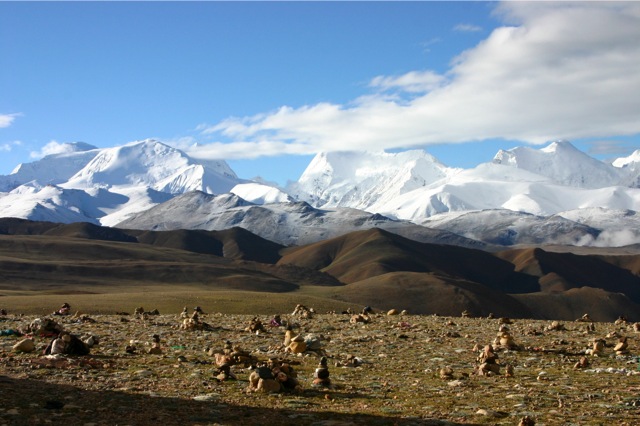
Early in the morning, we stopped for “breakfast’ on a high pass. A flat, gravel covered surface on which the customary prayer flag gate stood out sharply. It was quite icy, and a strong wind tore at the prayer flags and the white scarves previous visitors had left there as an offering to the mountain spirits.
Around the enormous plateau of the pass, snow covered peaks of the great Himalaya mountains gleamed at us – the peaks only, since we were already so high up! In the clean mountain air they seemed to be close enough to touch, yet the expanse of the mountain top we stood on appeared endless.

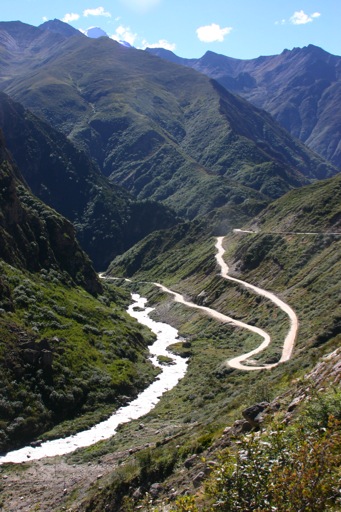 After this amazing view, we made our way down and through the Tibetan plateau, through smooth, sandy plains interspersed with shrubs, and bulging mountains looking like meat with their layers of dark and white stone. Truly an alien landscape.
After this amazing view, we made our way down and through the Tibetan plateau, through smooth, sandy plains interspersed with shrubs, and bulging mountains looking like meat with their layers of dark and white stone. Truly an alien landscape. As we descended downwards in a series of switchbacks, we observed life returning to the rocks – with a mighty mountain stream thundering past us and far below us, plants seemed to sprout all around us until we found ourselves in a humid greenhouse. At first, we relished the lush surroundings, but the increasingly crappy road (free massage/ chiropractics) and the heat made us more than a little travel-weary, especially because we’d dressed for the breakfast on the pass.
We still had a long, long way to go.
Zhangmu is complete insanity: It consists of a single road, which is a switchback road down the fissure. Trucks are parked everywhere, making it almost impossible to maneuver the streets. To make things worse, ahead of our bus is a truck that was so overloaded and tilted to the left that it sometimes literally had to squeeze between other cars. And all that at a snail’s pace or less.
Finally, finally, we reached the border. The border people were out for lunch, so we had to wait for their return. After they returned, we still had to wait (we are LEAVING, what is the problem ???), but finally we were through.
What followed was eight km of no-man’s land, with no-man’s-quality road. Little bus-taxis brought us to the Nepalese border, making us appreciate the quality of the previous dirt road, and the bus that we had left behind.
Finally, we crossed the Friendship bridge, and we were in Nepal!
The village of Zhangmu, which only exists because people have to get from China into Nepal somewhere, is, like the departure procedure of the border itself, an amusing exercise in inefficiency. The entire village consists of a clump of houses along a marginally broader version of the same crappy road we’d ridden all day. For some reason the place is crowded with trucks (none of which cross the border, we later find out), which squeeze past each other (or not), creating a giant fume-and-honk fest. The many parked trucks contribute to the fun.
Our original plan to be at the border before the Chinese officials embark on their lunch break evaporates as we, already inexplicably late, crawl through the truck group hug. 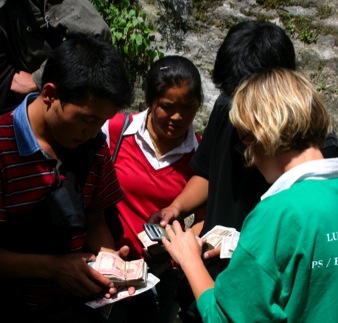

On the way, Dawa engages in obscure luggage-carrier-solicitations on his cell phone, and suddenly we are instructed to leave the bus, say goodbye to Dawa (the brave driver, not the guide) and Lobsang, and our luggage is being taken by a group of people materializing out of nowhere and teenage kids in school uniform crowd around us and want to change our Yuan into Nepalese rupees.
In a daze, we walk towards the Chinese border among the flock of Dawa-organized baggage carriers and money-changers until we come to a halt in front of the border station, and Dawa walks inside and Dorien instructs us to wait. So we wait. And wait.
At last, the border dudes seem to be back from their “schoteltjes” (“bowls,” our word for Chinese lunch). It seems no one wants to leave China but us – some people walk through and wave their ID at one of the guards…and we wait. At least, we spot our luggage on a truck on the other side. That was quick!
Eventually, we are allowed to leave, each passport being scrutinized, and to top it off we hand our SARS symptom form to a disinterested group of tea-drinking matrons.
On the other side, we are being ushered into jeeps (after an emotional goodbye to Dawa, our occasionally rambling but enthusiastic guide), and we cross the No-man’s-land between China and Nepal on the bumpiest road ever. I bumped my head into the jeep’s roof a couple of times, and my bowels became decidedly disentangled. Ouch ouch ouch ouch ouch.
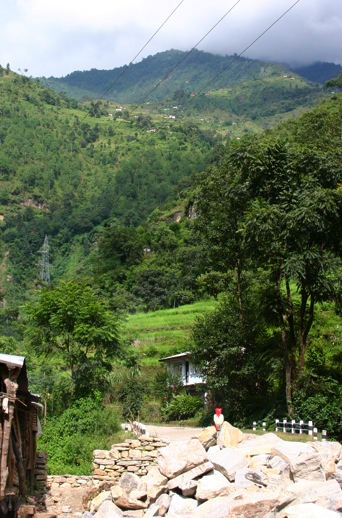 After lunch we were loaded into a new bus (which was barely large enough), and we were off to Kathmandu (a promised four hour drive). The beginning was very slow, because the road was very bad (again making us appreciate Tibetan dirt roads in retrospect), and because we were continuously stopped by Wannabe Maoists. The Maoists in Nepal stop people on the road and demand money to support their revolution. Apparently, other groups of misanthropes have caught up on the idea that you can just stop people on the road and demand money, making travel in Nepal no fun.
After lunch we were loaded into a new bus (which was barely large enough), and we were off to Kathmandu (a promised four hour drive). The beginning was very slow, because the road was very bad (again making us appreciate Tibetan dirt roads in retrospect), and because we were continuously stopped by Wannabe Maoists. The Maoists in Nepal stop people on the road and demand money to support their revolution. Apparently, other groups of misanthropes have caught up on the idea that you can just stop people on the road and demand money, making travel in Nepal no fun.I thought that the rest of the trip would be faster with better roads. Unfortunately not. The middle part is uphill, and the bus barely managed to crawl uphill, and the last part is through the suburbs of Kathmandu, where traffic is total chaos and subsequently slow.
Four hours turns out to be five and a half hours, and when we finally roll into the hotel courtyard we barely make it to our rooms and fall asleep instantly.
In the Nepalese border town of Kodari (not the least bit better than Zhangmu), we were chased into a Nepalese restaurant, where we were instructed to eat a genuine Nepalese dish (before entering Kathmandu with its Dutch Appeltaart and its German beer), while Dorien would do mysterious things to our passports and our luggage would be transferred to a bus.
The Nepalese dish (“Vegetable Set”) was delicious, another pearl in a string of great food experiences, but it was hot enough to peel back our gums and detonate our stomachs. Those having selected the “meat set” also had mutton, which consisted largely of hooves and fat, but that’s apparently as good as it gets here, meat-wise. We all cried and sniffed after the meal, and Dorien brought back our passports with a cute “arrival” sticker in them.
Time for the ever so lovely final leg of the trip –to Kathmandu – where the beauty of the landscape contrasted with the sheer pain of the bus ride itself.
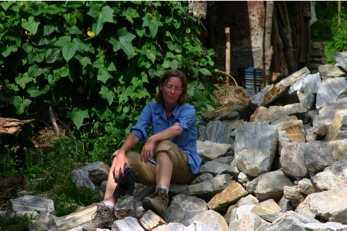 Neither “Airco” nor open windows were an option in our bus, so nothing relieved the humid heat. The bus wasn’t up to the mountain and huffed and puffed onwards at walking speed. Occasionally, our driver and his assistant would stop to open a hatch and tinker a bit.
Neither “Airco” nor open windows were an option in our bus, so nothing relieved the humid heat. The bus wasn’t up to the mountain and huffed and puffed onwards at walking speed. Occasionally, our driver and his assistant would stop to open a hatch and tinker a bit.Three times we were stopped by “Maoists” or those trying to be, who requested a “donation.” Their political program: “The current government sucks.” Presumably, these Maoists are not endorsed by China.
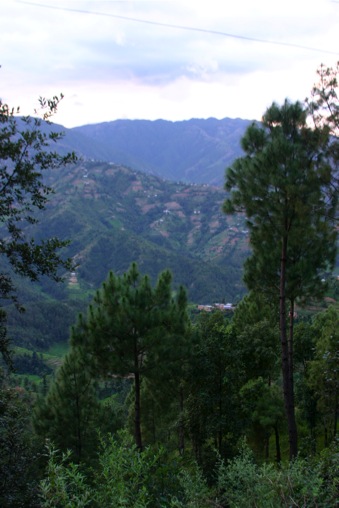 Driving in general seems erratic: People seem to have difficulty settling on left or right side traffic for a while, until around Kathmandu the consensus seems to fall on left-sided traffic, at least during the 0.2% of time the driver isn’t engaged in overtaking other cars while swerving around oncoming traffic in a charming eight-pattern.
Driving in general seems erratic: People seem to have difficulty settling on left or right side traffic for a while, until around Kathmandu the consensus seems to fall on left-sided traffic, at least during the 0.2% of time the driver isn’t engaged in overtaking other cars while swerving around oncoming traffic in a charming eight-pattern. For some reason, the steering wheel in our bus is on the left side, too, which explains the purpose of the co-driver, who leans out of the window to tell the driver when it is “safe” to overtake. At least the driver makes the sign of the cross (?) every time he overtakes – ah, the inner peace!
Lanes are regarded as amusing street decorations, it seems, as drivers minimize the efficiency of driving and maximize the thrill for oncoming traffic by using two lanes at the same time, all the time.
In Kathmandu itself, traffic degenerates into a decibel-rich mayhem that makes our arrival at the hotel a more or less random event. Dazed and traumatized we stagger into our rooms and towards the bed. For the first time in what seems like years, I share a bed with my husband.


